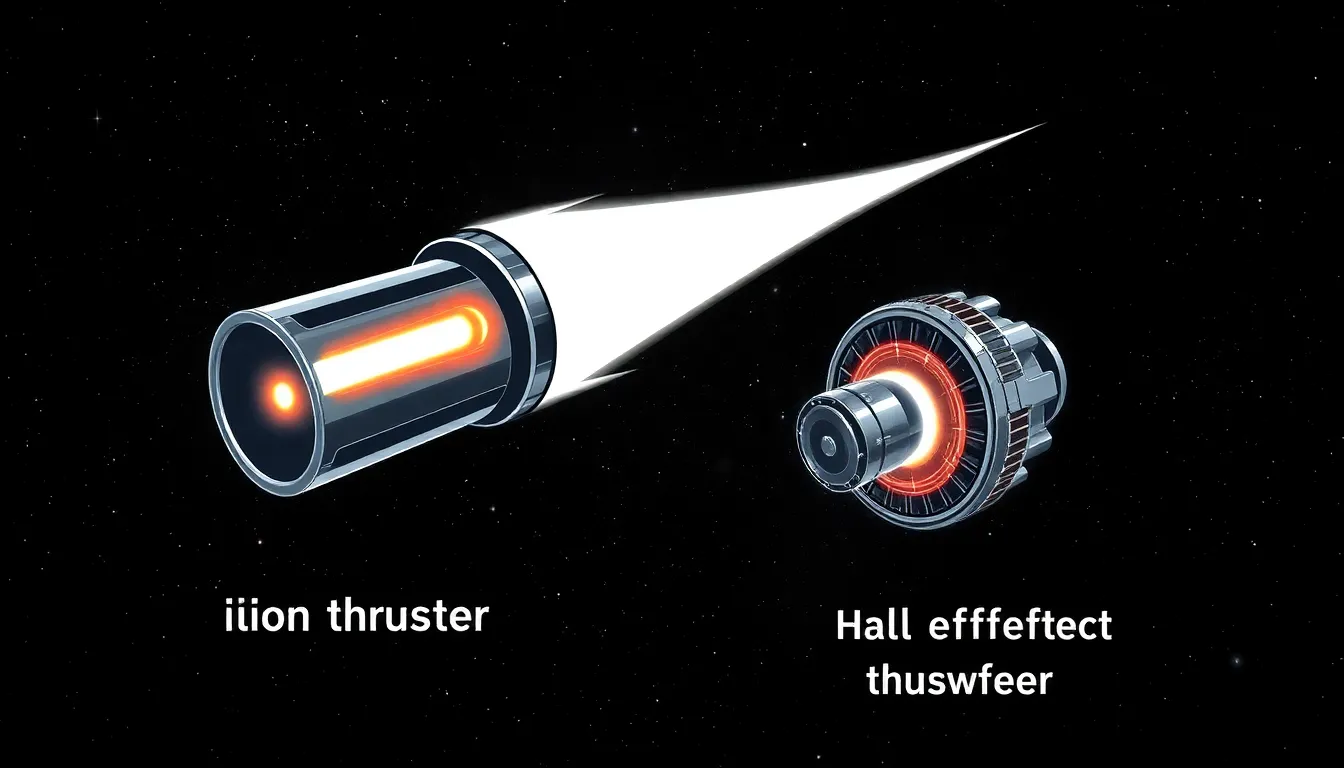In a world where gas prices soar higher than a rocket in space, electric propulsion is stealing the spotlight. Imagine zipping through the skies or gliding across the waters without the guilt of polluting the planet. It’s not just a dream; it’s the future of travel, and it’s here to save the day—one silent thrust at a time.
Table of Contents
ToggleOverview of Electric Propulsion
Electric propulsion utilizes electric energy to drive vehicles, shifting the dynamics of transportation. This technology employs electric motors that convert electrical energy into movement, leading to more efficient travel. As focus on reducing carbon emissions intensifies, electric propulsion becomes a cornerstone for sustainability.
Air transportation benefits significantly from electric propulsion systems. For instance, electric aircraft introduce lower operational costs and reduced noise levels compared to conventional planes. Solar-powered drones illustrate advancements in this field, demonstrating the potential for battery stores and renewable power sources to sustain flight.
Marine applications also showcase electric propulsion’s versatility. Electric ferries and vessels contribute to cleaner waterways, diminishing reliance on fossil fuels. In urban environments, electric boats offer serene travel experiences, allowing for an eco-friendlier alternative to traditional water transport.
An important aspect of electric propulsion is its adaptability across various sectors. Electric vehicles (EVs) redefine personal and public transport, with numerous manufacturers investing in enhanced battery technology. Significant advancements in charging infrastructure further support the transition to electric solutions.
Data indicates that global sales of electric vehicles surged by 108% in 2021, signaling a robust shift toward electric mobility. Additionally, research estimates electric propulsion could reduce greenhouse gas emissions by up to 70% in transit systems, underlining its environmental benefits.
Electric propulsion marks a significant leap towards sustainable transportation. Transitioning to electric methods not only helps mitigate climate change but also promotes energy efficiency and reduces operational costs across diverse travel modes.
Types of Electric Propulsion Systems

Electric propulsion systems encompass various technologies designed for improved efficiency in transportation. Among these, ion thrusters and Hall effect thrusters stand out as prominent options.
Ion Thrusters
Ion thrusters rely on ionizing gas to produce thrust. They emit ions using electric fields, which collide with neutral particles. These systems generate high specific impulses, making them suitable for deep space missions where fuel efficiency is critical. NASA’s Dawn spacecraft utilized ion thrusters, demonstrating their effectiveness in long-duration flights. Furthermore, they operate silently, reducing noise pollution in space. This technology offers advantages in high-precision maneuvers and long-term missions due to their low thrust but sustained efficiency.
Hall Effect Thrusters
Hall effect thrusters use electric and magnetic fields to accelerate ions, creating thrust. They operate using a continuous stream of gas, typically xenon, which gets ionized to produce charged particles. This type of thruster exhibits higher thrust levels compared to ion thrusters, making them ideal for various spacecraft applications. They’re widely used in satellite station-keeping and orbit raising, showcasing responsiveness in real-time maneuvers. The European Space Agency employed hall effect thrusters on its BepiColombo mission, illustrating their viability in interplanetary travel. Overall, Hall effect thrusters balance efficiency, thrust, and operational flexibility in electric propulsion.
Applications of Electric Propulsion
Electric propulsion technology finds wide-ranging applications in various fields, significantly impacting spacecraft and satellite operations.
Spacecraft Propulsion
Electric propulsion systems play an essential role in spacecraft maneuverability and efficiency. Ion thrusters deliver high fuel efficiency, making them suited for deep space missions where sustainability is crucial. NASA’s Dawn spacecraft exemplifies this technology by employing ion thrusters for its journey to the asteroid belt. Hall effect thrusters also contribute significantly, providing higher thrust levels necessary for quicker transitions between orbit and deep space travel. Both systems enhance operational flexibility, allowing spacecraft to perform complex missions with reduced fuel consumption, which in turn supports longer missions with limited resources.
Satellite Station Keeping
Maintaining satellites in their designated orbits relies heavily on electric propulsion. Hall effect thrusters facilitate precise movements that ensure satellites stay on course, preventing drift. This method reduces fuel usage by optimizing the thrust-to-weight ratio. Increased efficiency translates to extended operational lifetimes, as satellites like those used in global positioning systems benefit from this technology. Additionally, electric propulsion systems allow for minimized vibrations, enhancing the stability and longevity of sensitive onboard instruments. Overall, electric propulsion represents a cornerstone in satellite maintenance, promoting sustainability within the space sector.
Advantages of Electric Propulsion
Electric propulsion offers multiple benefits that enhance travel efficiency and sustainability. Significant advantages include improved efficiency and performance as well as a positive environmental impact.
Efficiency and Performance
Electric propulsion systems provide superior efficiency compared to traditional fuel-based systems. Energy conversion occurs with minimal waste, resulting in better energy utilization. Electric motors also deliver instant torque, facilitating quick acceleration. For instance, electric vehicles achieve remarkable performance metrics with significantly less energy input, leading to lower operational costs. In the aerospace sector, electric aircraft demonstrate reduced maintenance needs due to fewer moving parts, further enhancing overall efficiency. A notable 2021 study indicated that electric propulsion could enhance overall vehicle performance by up to 40% compared to conventional engines.
Environmental Impact
The environmental advantages of electric propulsion are substantial. Significant reductions in greenhouse gas emissions occur with the transition to electric systems. Electric vehicles have the potential to lower emissions by up to 70%, significantly alleviating air pollution. Additionally, electric propulsion reduces noise levels, creating a quieter urban environment. Solar-powered drones and electric ferries exemplify how clean energy can transform transportation methods while promoting ecological sustainability. These innovations support a cleaner atmosphere, aligning with global efforts to combat climate change. Adopting electric propulsion signifies a crucial step towards achieving emissions-reduction goals and fostering sustainable travel practices.
Challenges and Limitations
Electric propulsion faces several challenges that impact its widespread adoption in transportation sectors.
Technical Challenges
Technical challenges significantly hinder the advancement of electric propulsion systems. Battery technology remains a critical issue, with limitations in energy density affecting range and charging times. Current battery packs fall short in providing sufficient energy for long-duration flights or voyages. Additionally, integration with existing infrastructure poses hurdles; many facilities require upgrades to accommodate charging stations. Thermal management also presents difficulties, as electric systems generate heat that needs proper dissipation to ensure efficiency and safety. Research continues into solutions, but overcoming these technical barriers is essential for the technology’s growth.
Cost Considerations
Cost considerations are a prominent barrier in the electric propulsion landscape. Initial investment remains high, with electric vehicles and related infrastructure requiring substantial capital. Developing adequate charging networks demands significant funding, which can deter investors. While operational costs tend to lower over time due to fuel savings and maintenance reductions, the upfront expenses often challenge consumers and businesses alike. Studies indicate that the total ownership costs for electric vehicles may equal or surpass those of traditional vehicles in some cases, depending on various factors. Addressing these financial hurdles is essential for accelerating electric propulsion adoption.
Electric propulsion is reshaping the landscape of transportation by prioritizing sustainability and efficiency. Its adaptability across various sectors from aviation to marine travel showcases its potential to significantly reduce greenhouse gas emissions and operational costs. As innovations continue to emerge and infrastructure evolves, the journey toward a cleaner and more efficient future seems promising.
Overcoming challenges related to battery technology and initial costs will be crucial for broader adoption. However the benefits of electric propulsion are clear. This technology not only enhances vehicle performance but also supports global efforts to combat climate change. The future of transportation is electric and it’s paving the way for a more sustainable world.







